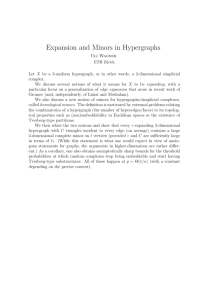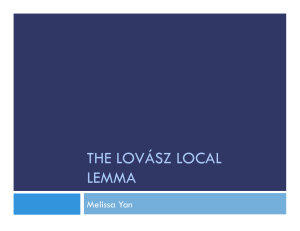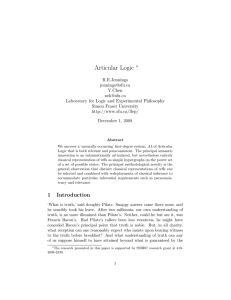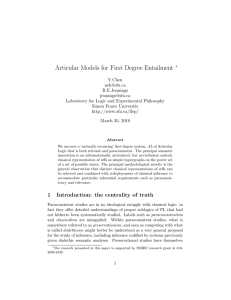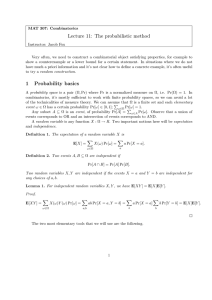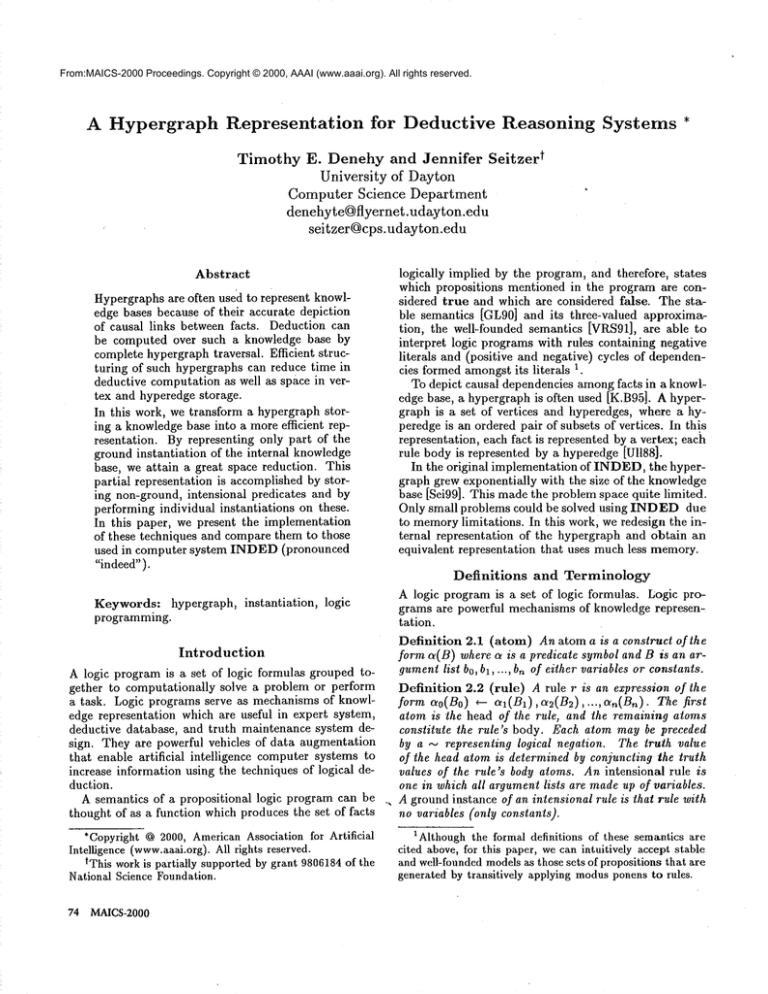
From:MAICS-2000 Proceedings. Copyright © 2000, AAAI (www.aaai.org). All rights reserved.
A Hypergraph Representation
tTimothy
for
Reasoning
Systems
*
E.
Denehy and Jennifer
Seltzer
University
of Dayton
Computer Science
Department
denehyte@flyernet.udayton.edu
seitzer@cps.udayton.edu
Abstract
Hypergraphs are often used to represent knowledge bases because of their accurate depiction
of causal links between facts. Deduction can
be computed over such a knowledge base by
complete hypergraph traversal. Efficient structuring of such hypergraphs can reduce time in
deductive computation as well as space in vertex and hyperedge storage.
In this work, we transform a hypergraph storing a knowledgebase into a more efficient representation. By representing only part of the
ground instantiation of the internal knowledge
base, we attain a great space reduction. This
partial representation is accomplished by storing non-ground, intensional predicates and by
performing individual instantiations on these.
In this paper, we present the implementation
of these techniques and compare them to those
used in computer system INDED(pronounced
"indeed").
Keywords: hypergraph, instantiation,
programming.
logic
Introduction
A logic program is a set of logic formulas grouped together to computationally solve a problem or perform
a task. Logic programs serve as mechanisms of knowledge representation which are useful in expert system,
deductive database, and truth maintenance system design. They are powerful vehicles of data augmentation
that enable artificial
intelligence computer systems to
increase information using the techniques of logical deduction.
A semantics of a propositional logic program can be
thought of as a function which produces the set of facts
*Copyright @2000, AmericanAssociation for Artificial
Intelligence (www.aaai.org).All rights reserved.
tThis work is partially supported by grant 9806184of the
National Science Foundation.
74 MAICS-2000
Deductive
logically implied by the program, and therefore, states
which propositions mentioned in the program are considered true and which are considered false. The stable semantics [GL90] and its three-valued approximation, the well-founded semantics [VRS91], are able to
interpret logic programs with rules containing negative
literals and (positive and negative) cycles of dependencies formed amongstits literals 1
To depict causal dependencies amongfacts in a knowledge base, a hypergraph is often used [K.B95]. A hypergraph is a set of vertices and hyperedges, where a hyperedge is an ordered pair of subsets of vertices. In this
representation, each fact is represented by a vertex; each
rule body is represented by a hyperedge lUll88].
In the original implementation of INDED,the hypergraph grew exponentially with the size of the knowledge
base [Sei99]. This made the problem space quite limited.
Only small problems could be solved using INDEDdue
to memorylimitations. In this work, we redesign the internal representation of the hypergraph and obtain an
equivalent representation that uses much less memory.
Definitions
and Terminology
A logic program is a set of logic formulas. Logic programs are powerful mechanisms of knowledge representation.
Definition 2.1 (atom) An atom a is a construct of the
form a(B) where a is a predicate symbol and B is an argumentlist bo, bl, ..., bn of either variables or constants.
Definition 2.2 (rule) A rule r is an expression of the
form ~0(B0) ~-- Oel(B1), ot2(B2),..., otn(Bn). The first
atom is the head of the rule, and the remaining atoms
constitute the rule’s body. Each atom may be preceded
by a ~ represenling logical negation. The truth value
of the head atom is determined by conjuncting the truth
values of the rule’s body aloms. An intensional rule is
one in which all argument lists are made up of variables.
A ground instance of an intensional rule is that rule with
no variables (only constants).
1Althoughthe formal definitions of these semantics are
cited above, for this paper, we can intuitively accept stable
and welt-foundedmodelsas those sets of propositions that are
generated by transitively applying modusponens to rules.
Definition 2.3 (logic program) A logic program
is a set of intensional rules. The ground instantiation of
a logic programPc is constructed by forming all possible
ground instances of the rules of P with a set of constants
C.
Original
Hypergraph
Representation
A large part of this work was implemented by studying
some of the shortcomings of the hypergraph representation of system INDED. As mentioned above, the complete structure was generated and traversed for input
files that mayonly have required partial generation and
traversal. Before discussing our reduction techniques, we
first describe this knowledgebased system.
System INDEDis a knowledge discovery system that
uses inductive logic programming (ILP) [LD94] as its
discovery technique. To maintain a database of background knowledge, INDEDhouses a deduction engine
that uses deductive logic programming to compute the
current state (current set of true facts) as new rules and
facts are procured.
Inductive
Logic Programming
Inductive logic programming(ILP) is a research area
artificial intelligence that attempts to attain someof the
goals of machinelearning while using the techniques, language, and methodologies of logic programming. Some
of the areas to which ILP has been applied are data
mining, knowledgeacquisition, and scientific discovery
[LD94]. The goal of an inductive logic programmingsystem is to output a rule which covers (entails) an entire
set of positive observations, or examples, and excludes or
does not cover a set of negative examples [Mug92]. This
rule is constructed using a set of knownfacts and rules,
knowledge, called domain or background knowledge. In
essence, the ILP objective is to synthesize a logic program, or at least part of a logic programusing examples,
background knowledge, and an entailment relation.
augment the deductive engine’s hypergraph. We use
a standard top-down hypothesis construction algorithm
(learning algorithm) in INDED[LD94].This algorithm
uses two nested programming loops. The outer (covering) loop attempts to cover all positive examples, while
the inner loop (specialization) attempts to exclude all
negative examples. Termination is dictated by two userinput values to indicate sufficiency and necessity stopping criterea. The following diagram illustrates the discovery constituents of INDEDand their symbiotic interaction.
Architecture
~
~
B= B-I-
t
NDUCTIVE
of System INDED
ENGINE
DEDUCTIVE
ENGINE
Top-Down
JTMS [
Empirical [ w/ds’~t~ [ Nonmonotonic[
Reasoning h
LeaPer
~di.,~
System
I I
UB’I
The input files to INDEDthat initialize
the system
are the extensional database (EDB) and the intensiona’l
database (IDB). The EDBis made up of initial ground
facts (facts with no variables, only constants). The IDB
is made up of universally quantified rules with no constants, only variables. Together, these form the ground
instantiation represented internally as the deduction engine hypergraph. Weformally define hypergraph as follows.
Definition 3.4 (hypergraph representation)
Let
Pc be a ground instantiation of a logic programwith constant set C, and let A be the set of unique atoms within
Pc. The hypergraph representation G of Pc has vertex
set Gv = A and edge set Gs = { (ao,S) I S r E Pc with
head atom ao and a set of body atoms S } . Each edge
part also contains the negation status of its respective
body atom.
Architecture
of INDED
System INDEDis comprised of two main computation
engines. The deduction engine is a bottom-up reasoning
system that computes the current state by generating a
Reduced Hypergraph
Representation
stable model 2, if there is one, of the current ground
instantiation represented internally as a hypergraph,
The size of the original hypergraph representation grows
and by generating the well-founded model [VRS91], if
exponentially with the number of constants. Because
there is no stable model[GL90]. This deduction engine
this representation is based on a set of ground instances
is, in essence, a justification truth maintenance system
of intensional rules, it can be seen that the hyper[Doy79] which accommodates non-monotonic updates in
graph produced consists of several subgraphs with simthe forms of positive or negative facts.
ilar structure. These subgraphs contain vertices with
The induction engine, using the current state created
identical predicate expressions and similar edge configby the deduction engine as the background knowledge
+
-,
urations. They differ, however, in the constant argubase, along with positive examples E and negative
ments making up each atom. This observation motivates
examples £- , induces a rule(s) which is then used
the construction of a reduced hypergraph representation
based solely on the intensional rules of a logic program
2Althoughthe formal definitions of these semantics are
(not on their ground instances). Such a reduction can
cited above, for this paper, we can intuitively accept stable
be
accomplished by simplifying the vertices and adding
and well-foundedmodelsas those sets of facts that are geninformation to the edges of the hypergraph.
erated by transitively applying modusponensto rules.
Knowledge-andReasoning-Based
Systems75
The vertices of the new hypergraph will contain predicate expressions that can be instantiated with a list of
constants to form a conventional atom.
Definition 4.5 (iustantiation)
An instantiation
a list to, il, ..., in of either constantsor variables.
I is
Traversing the edges in the hypergraph representation
produces a set containing a rule’s body atoms. In order
to obtain the correct instantiation of each predicate expression in the body, we must define a translation from
the head atom’s constant arguments to those found in
the body atom.
Definition 4.6 (translation)
A translation T is a list
to,t1, ...,tn of integers representing instantiation positions. The application of T to instantiation I yields
a new instantiation
T(I) = J with jo = ito,Jl
iq, ...,jn = it,.
The lists of arguments in a rule’s body atoms may
contain constants that do not appear in the head atom’s
arguments. Therefore, we must define an augmented
instantiation that includes these additional constants.
This new instantiation will be applied to the head predicate expressions in the hypergraph to form a head atom,
and it will serve as the basis for the translations to the
body atoms.
Definition 4.7 (augmented instantiation)
For a ru/e r o/the form ~0(B0) ~ ~1(B1), ~(B~),
~n(Bn), let B~o be the list of unique variables appearing
in B1, B2, ..., Bn but not in Bo. The augmentedinstantiation BA is defined such that bao = boo, bA1 = b01, ...,
bAi =boi, bA(i+l) =btoo, ..., bA(i+j+2)~- b~oj.
Since each translation corresponds to a specific edge
part, we form associations between rules, predicate expressions in the rule’s body, and the translation used
to traverse from the head of the rule to that predicate
expression.
Definition 4.8 (association) For an intensional rule
r with head atom ~0(B0), a body atom ~i(Bi), and the
augmentedinstantiation BA , an association is a 3-tuple
(r, ~i, T) such that T(BA) =
Finally, we can describe the reduced hypergraph representation of a logic program in terms of our previous
definitions.
Definition
4.9 (reduced hypergraph) Let P be a
logic programwith a set of unique predicate expressions
A. The reduced hypergraph representation H of P has
vertex set Hv = A and edge set HE = { (O~o,S,U)[
3 r E P with head predicate expression so, a set of body
predicate expressions S, and the set U of all associations
(r, cq, Ti) }. Each edge part also contains the negation
status of its respective body predicate expression.
The important aspect of this work is the realization
that the reduced hypergraph representation maintains
the same functionality as the original hypergraph representation.
76 MAICS-2000
Theorem 4.10 Let P be a logic program and C a set of
constants. The reduced hypergraph representation H of
P along with a set of instantiations of constants from C
is equivalent to the original hypergraph representation G
of PC.
Proof." For each rule r of the form o~0(B0) ~-cq(Ba),o~2(B2),...,c~n(B,)
in Pc, there exist atom
vertices ao,al,...,an
in Gv and predicate expression vertices Oto, oq, ..., o~n in Hr. GE contains
an edge (a0,{al,...,a,}),
and Hs contains an edge
(O~o, {oq,...,Otn},U).
Let BA be the augmented instantiation derived from Bo, 131, ..., B,~.
Applying instantiation
BA to o~o yields a vertex equivalent to ao.
Utilizing the transitions
T from
the associations
in U yields the set of atoms
{Cel(TI(BA)) = al, ..., OLn(Tn(BA))= an}. Thus,
plication of an instantialion from C yields a vertex and
an edge in H equivalent to those found in G.
Example
Consider the logic program P
propersubset(X, Y) ~ subset(X, Y) ,~ subset(Y,
This program determines if X is a proper subset of
Y based on whether or not X is a subset of Y and Y
is a subset of X. Consider the relation between the
set of vehicles and the set of cars. Wewill describe
these sets with the set of constants C = {v,c}. Figure 1 shows the hypergraph representation
Pc. This
hypergraph demonstrates every possible proper subset
relation between vehicles and cars, and traversing the
edges leads to the basis facts upon which each relation
may be true. It can be seen that the subgraph containing propersubset (v,v) is very similar to the subgraph containing propersubset (c, c). This is also true
for the subgraphs containing propersubset (v,c) and
propersubset(c, v)
(propersubset(v,v)~-
su bset(v.v))
propersubset(v,c)
subset(v,c)
(propersubset(c,v)
subset(c,v)
(propersubset(c,c)~_____________L..
- - ~ subset(c,c)
Figure 1: Original Hypergraph l~epresentation
of Pc
The reduced hypergraph representation
of P and
the set of possible constant instantiations
from C
is shown in Figure 2. Applying each of the instantiations
to the propersubset vertex produces a
subgraph of Pc.
For example, applying the instantiation
[v,c] to the propersubset vertex produces atom propersubset(v,c).
Traversing the positive edge part and applying the translation T(0, 1)
produces subset(v,c).
Traversing the negative edge
part and applying the translation
T(1,0) produces
subset(c, v).
T(0,1)
TO,O)
Instantiations
fv,vlIv,cl[c,vl[c.cl
Figure 2: Reduced Hypergraph Representation
Algorithm
for Reduced
Construction
of P
Hypergraph
The method for constructing the reduced hypergraph
representation
of a logic program is given in Algorithm 6.11.
Algorithm 6.11 Reduced Hypergraph Construction
for each rule r of the form
s0(Bo) ~ cq(B1), s2(B2), s,~(Bn) in P {
set the augmentedinstantiation size for r to 0
if o~0 is not in the predicate expression set {
add s0 to the predicate expression set
create a new vertex v for (~0
}
else {
retrieve vertex v for s0
}
create a new edge e emanating from v
for each variable bi in B0 {
if bl is not in the variable list of r {
add bi to the variable list of r
increment augmented instantiation size for r
}
}
for each ai in the body of r {
if si is not in the predicate expression set {
add ~i to the predicate expression set
create a new vertex vi for ~
}
else {
retrieve vertex vi for (~i
}
create a new translation T
for each variable bj in Bi {
if bI is not in the variable list of r {
add bj to the variable list of r
increment augmentedinstantiation size for r
}
retrieve the index k of bj in the variable list of r
add position k to translation T
}
add subedge (v, vi) to e with translation
optional negation from ai
T and
Current
Implementation
and Future
Work
The reduced hypergraph representation for logic programs has been implemented using C++ and STL. This
representation has been used to perform deduction by
wayof the Bilattice algorithm [Sei97] for finding a wellfounded model, and the results have been verified using
the previous implementation of INDED.In the future,
the hypergraph representation will be augmented to allow for induction.
The reduced hypergraph representation also provides
a firm basis for the parallelization of logic programming
algorithms. Because of its reduced size, the hypergraph
can be constructed on each of the slave nodes in a multiprocessor or distributed system. The master node can
then distribute a set of constant instantiations to each
of the slave nodes to constitute their work load for processing. Our future work will include the parallelization
of these hypergraph algorithms using MPIon a Beowulf
cluster.
References
[Doy79] J. Doyle. A truth maintenance system. Artificial Intelligence, 12:231-272, 1979.
[GL90]Michael Gelfond and .Vladimir Lifschitz. The
stable model semantics for logic programming.
In Proceedings of the Fifth Logic Programming
Symposium, pages 1070-1080, 1990.
[K.B95] K.Berman, et. al. Computing the well-founded
semantics faster. Lecture Notes in Artificial Intelligence, 928, 1995.
[LD94] Nada Lavrac and Saso Dzeroski. Inductive
Logic Programming.Ellis Horwood,Inc., 1994.
[Mug92] Stephen Muggleton, editor. Inductive Logic
Programming. Academic Press, Inc, 1992.
[Sei97] Jennifer Seltzer. A study of the well-founded
and stable logic programming semantics. PhD
thesis, University of Cincinnati, 1997.
[Sei99] Jennifer Seltzer. INDED:A symbiotic system
of induction and deduction. In MAICS-99Proceedings Tenth Midwest Artificial Intelligence
and Cognitive Science Conference, pages 9399. AAAI, 1999.
[u1188]
Jeffrey D. Ullman. Principles of Database and
Knowledge-Base Systems, Vol L Computer Science Press, Inc., 1988.
[vRs91]A. VanGelder, K. Ross, and J. Schlipf. The
well-founded semantics for general logic programs. Journal of the ACM, 38(3):620-650,
July 1991.
Knowledgeand Reasoning-Based
Systems77

